Remove the intake CVVT assembly (A) and exhaust CVVT assembly (B).
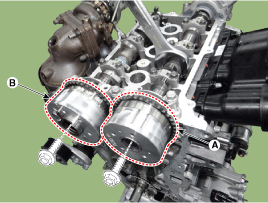
When removing the CVVT assembly hold the camshaft with a wrench to prevent the camshaft from rotating.
Remove the cylinder head cover.
(Refer to Cylinder Head Assembly - “Cylinder Head Cover”)
Remove the vacuum pump.
(Refer to Cylinder Head Assembly - "Vacuum Pump")
Remove the timing chain.
(Refer to Timing System - “Timing Chain”)
Remove the intake CVVT assembly (A) and exhaust CVVT assembly (B).

When removing the CVVT assembly hold the camshaft with a wrench to prevent the camshaft from rotating.
Remove the camshaft front bearing cap (A), camshaft middle bearing cap (B), and camshaft rear bearing cap (C) in the sequence shown.
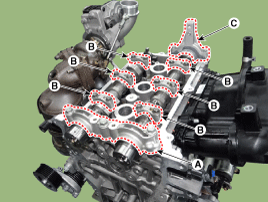
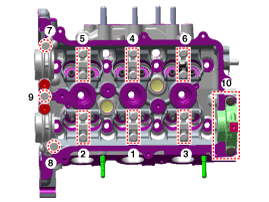
Remove the camshafts (A).
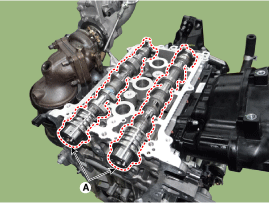
Inspect cam lobes.
Using a micrometer, measure the cam lobe height.
Cam height
Intake : 41.79824 mm (1.6456 in)
Exhaust : 41.57000 mm (1.6366 in)
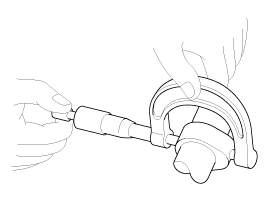
If the cam lobe height is less than standard, replace the camshaft.
Inspect the camshaft journal clearance.
Clean the bearing caps and camshaft journals.
Place the camshafts on the cylinder head.
Lay a strip of plastigage across each of the camshaft journals.
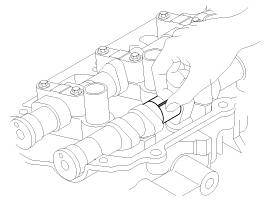
Install the camshaft front bearing cap (A), camshaft middle bearing cap (B), and camshaft rear bearing cap (C) in following method by tightening to the specified torque.
Tightening torque :
Step 1
A : 9.8 N.m (1.0 kgf.m, 7.2 lb-ft)
B : 5.9 N.m (0.6 kgf.m, 4.3 lb-ft)
Step 2
A : 18.6 ~ 22.6 N.m (1.9 ~ 2.3 kgf.m, 13.7 ~ 16.6 lb-ft)
B : 11.8 ~ 13.7 N.m (1.2 ~ 1.4 kgf.m, 8.7 ~ 10.1 lb-ft)
C : 11.8 ~ 13.7 N.m (1.2 ~ 1.4 kgf.m, 8.7 ~ 10.1 lb-ft)

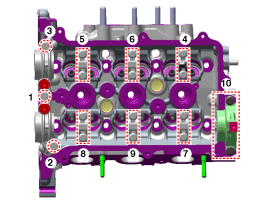
Do not turn the camshaft.
When cam caps are installed, the arrows on top of caps must point outward from the engine.
Remove the bearing caps.
Measure the plastigage at its widest point.
Camshaft bearing oil clearance
Intake :
0.027 ~ 0.057 mm (0.0010 ~ 0.0022 in)
Exhaust :
0.027 ~ 0.057 mm (0.0010 ~ 0.0022 in)
Camshaft journal outer diameter
Intake / Exhaust No.1:
36.464 ~ 36.478 mm (1.4356 ~ 1.4361 in)
Intake / Exhaust No.2~5 :
20.964 ~ 20.978 mm (0.8254 ~ 0.8259 in)
Camshaft journal bore inner diameter
Intake / Exhaust No.1:
36.505 ~ 36.521 mm (1.4372 ~ 1.4378 in)
Intake / Exhaust No.2~5 :
21.005 ~ 21.021 mm (0.8270 ~ 0.8276 in)
If the oil clearance is greater than maximum, replace the camshaft. If necessary, replace cylinder head.
Completely remove the plastigage.
Remove the camshaft.
Inspect the camshaft end play.
Install the camshaft (A).

Install the camshaft front bearing cap (A), camshaft middle bearing cap (B), and camshaft rear bearing cap (C) in following method by tightening to the specified torque.
Tightening torque :
Step 1
A : 9.8 N.m (1.0 kgf.m, 7.2 lb-ft)
B : 5.9 N.m (0.6 kgf.m, 4.3 lb-ft)
Step 2
A : 18.6 ~ 22.6 N.m (1.9 ~ 2.3 kgf.m, 13.7 ~ 16.6 lb-ft)
B : 11.8 ~ 13.7 N.m (1.2 ~ 1.4 kgf.m, 8.7 ~ 10.1 lb-ft)
C : 11.8 ~ 13.7 N.m (1.2 ~ 1.4 kgf.m, 8.7 ~ 10.1 lb-ft)


Do not turn the camshaft.
When cam caps are installed, arrows on the top of caps must point to out side of engine.
Using a dial indicator, measure the end play while moving the camshaft back and forth.
Camshaft end play :
Intake :
0.1 ~ 0.2 mm (0.0039 ~ 0.0078 in)
Exhaust :
0.1 ~ 0.2 mm (0.0039 ~ 0.0078 in)

If the end play is greater than maximum, replace the camshaft. If necessary, replace cylinder head.
Remove the camshafts.
Inspect the CVVT assembly.
Clamp the camshaft using a vise. Be careful not to damage the cam lobes and journals in the vise.
Check that the CVVT is locked by turning it clockwise or counterclockwise. It must not rotate.
Intake CVVT : Seal one of the two advance holes in the camshaft journal with tape.
Exhaust CVVT : Seal one of the two retard holes in the camshaft journal with tape.
[Intake]
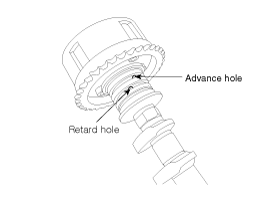
[Exhaust]
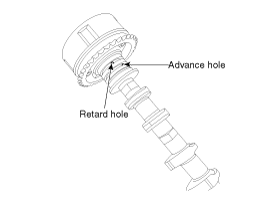
Intake CVVT : Apply approx. 150 kPa (1.5 kgf/㎠, 21 psi ) of compressed air into the unsealed advance hole to release the lock.
Exhaust CVVT : Apply approx. 150 kPa (1.5 kgf/㎠, 21 psi ) of compressed air into the unsealed retard hole to release the lock.
Cover the oil paths with a piece of cloth when applying compressed air to prevent oil from spraying.
Intake CVVT : With compressed air applied, rotate the CVVT into the advance direction (counterclockwise) within its phasing range and check that the CVVT turns smoothly.
Exhaust CVVT : With compressed air applied, rotate the CVVT into the retard direction (clockwise) and check that the CVVT turns smoothly.
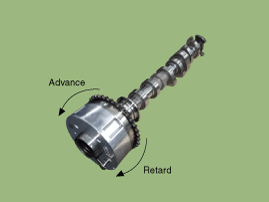
CVVT phasing range
Intake :
25˚ (from the most retarded position to the most advanced position)
Exhaust :
20˚ (from the most advanced position to the most retarded position)
Intake CVVT : Rotate the CVVT into the most retarded position (clockwise) and then check that the CVVT is locked.
Exhaust CVVT : Rotate the CVVT into the most advanced position (counterclockwise) and then check that the CVVT is locked.
Install the camshafts (A).

Install the camshaft front bearing cap (A), camshaft middle bearing cap (B), and camshaft rear bearing cap (C) in the sequence shown.
Tightening torque :
Step 1
A : 9.8 N.m (1.0 kgf.m, 7.2 lb-ft)
B : 5.9 N.m (0.6 kgf.m, 4.3 lb-ft)
Step 2
A : 18.6 ~ 22.6 N.m (1.9 ~ 2.3 kgf.m, 13.7 ~ 16.6 lb-ft)
B : 11.8 ~ 13.7 N.m (1.2 ~ 1.4 kgf.m, 8.7 ~ 10.1 lb-ft)
C : 11.8 ~ 13.7 N.m (1.2 ~ 1.4 kgf.m, 8.7 ~ 10.1 lb-ft)


Install the intake CVVT assembly (A) and exhaust CVVT assembly (B).
Tightening torque :
63.7 ~ 73.5 N.m (6.5 ~ 7.5 kgf.m, 47.0 ~ 54.2 lb-ft)

When installing the CVVT assembly hold the camshaft with a wrench to prevent the camshaft from rotating.
Install the remaining parts in the reverse order of removal.